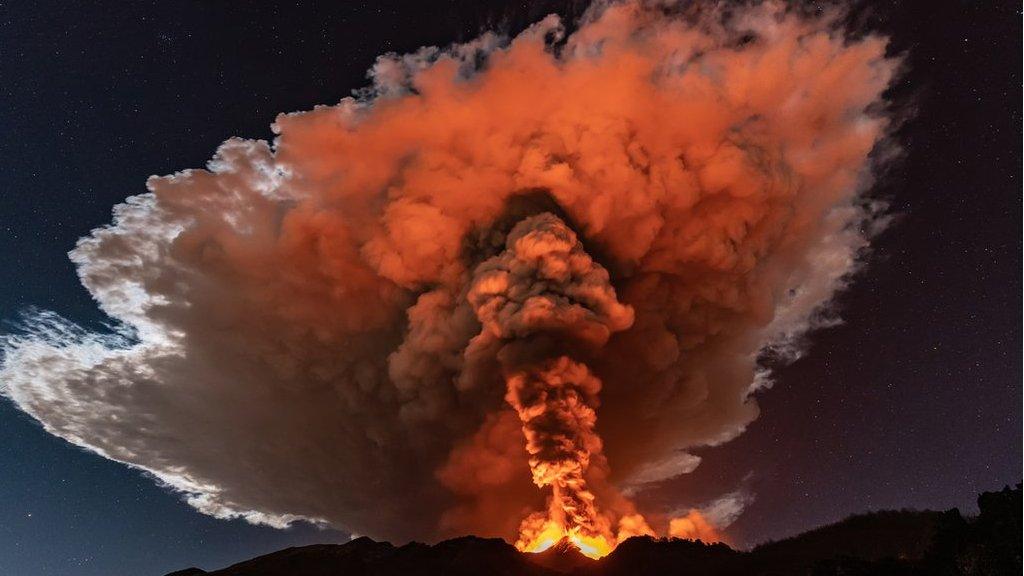Etna: Life beneath the volcanic dust of repeated eruptions
- Published
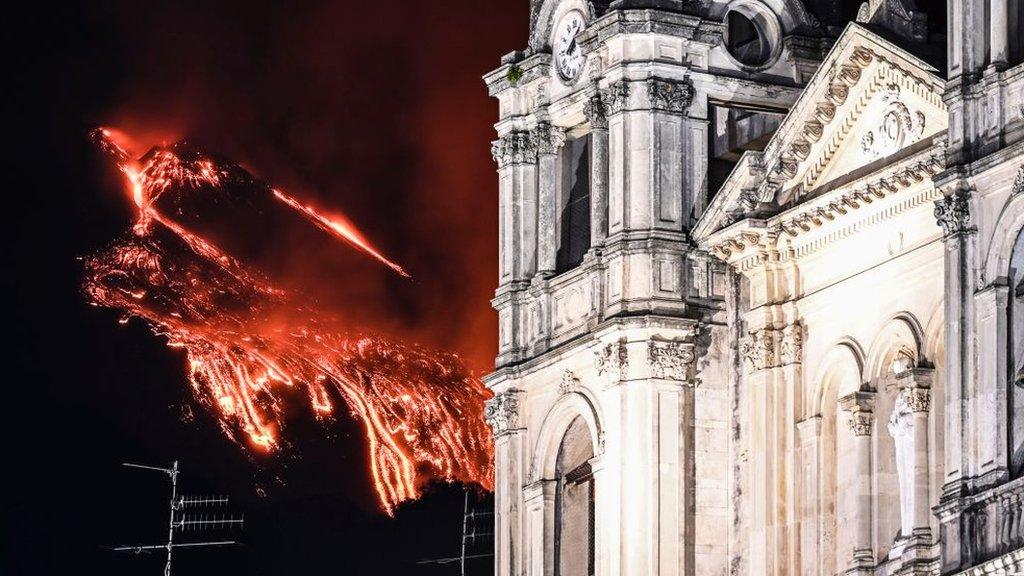
Irene Corsaro will never forget her first driving lesson under a rain of black ash from Mount Etna. Like many Sicilians from Catania, the 18-year-old has learnt quickly how to make her way home on a road covered in volcanic dust during one of the volcano's 11 eruptions in the past three weeks. A 12th eruption was under way on Friday.
Every so often, the volcano's four main craters awake with intense, simultaneous blasts. These episodes create a spectacular natural firework display, replete with bubbles, fountains and flows of lava. Within minutes, neighbouring towns and villages are showered with flakes of ash and other debris.
'Lava falling on my roof'
Irene's trip with her mother through the deserted streets of her home town of Nicolosi, on Etna's slopes, turned into a nightmare when her Peugeot 107 car was stopped by a sound she had never heard before.
"It was like a sudden crackling; like hail pouring down and popping around. I thought it was because of the ash on the street," she said. "Instead, it was fragments of lava (lapilli) falling on both my roof and my windscreen from a giant red cloud right over me."
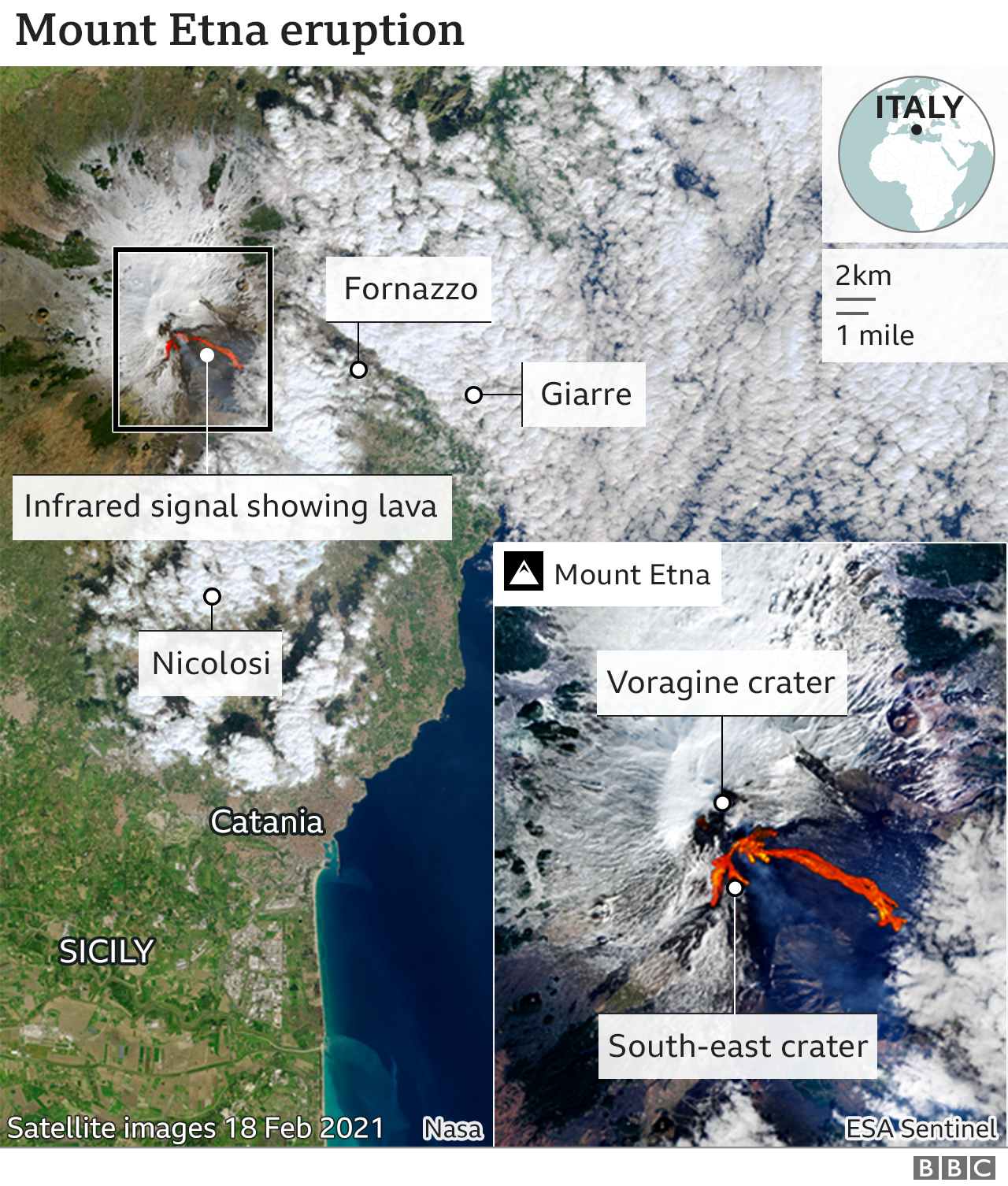

It was 16 February and the sky was already inflamed by the sunset. It was to be the first in an array of violent episodes on Etna, increasing in power each time. Those paroxysms have since come in the middle of the night, at sunrise, during a storm and even under the light of a full moon.
Irene Corsaro could feel the stones grinding under the car's tyres and she soon realised how lucky she was to be wearing her anti-Covid facemask. "The red-coloured air was very poor, heavy to breathe in." They rushed home to pack in case they needed to evacuate.
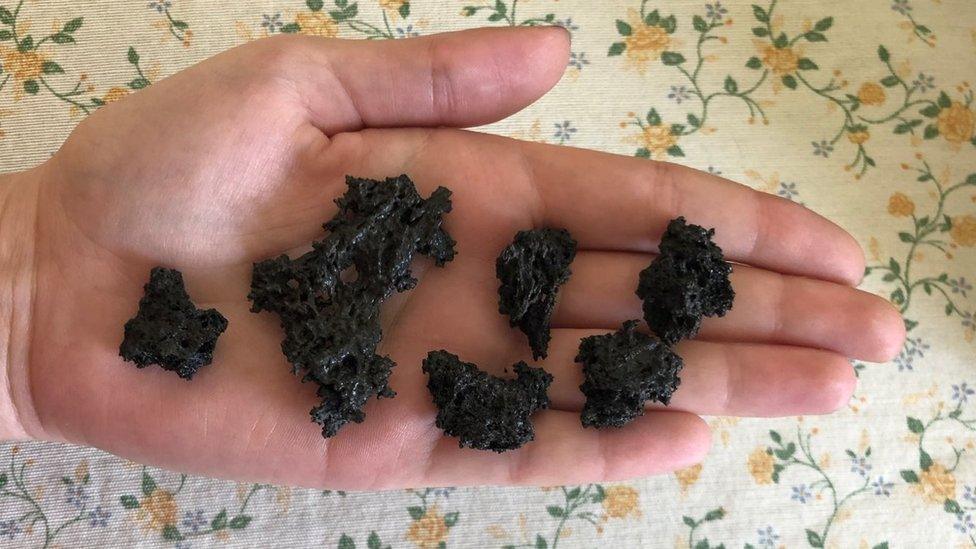
Irene Corsaro shows some of the fragments of lava that showered her car
Clouds of sulphur dioxide (SO2), visible from space, have reached as far away as China. But the ash and the heavier lapilli stay local. They drape the sides of the volcano and blanket at least 16 towns around Etna's cone. Fornazzo, Giarre and Zafferana are among those affected, and even coastal towns like Riposto and Torre Archirafi.
Etna has released some 40 million cubic metres of volcanic material, says volcanologist Boris Behncke, who monitors Etna closely for the National Institute of Geophysics and Volcanology (INGV).

"It is quite a lot," he tells the BBC. In comparison, the Etna eruption that threatened the town of Randazzo in 1981 released a mere 20 million cubic metres of material.
Watching Etna's destructive power
From my window, 20km (12 miles) south-east of Etna's summit, I have an unbroken view of the volcano. There is something primordial about being indoors as nature unleashes its energy.
It starts with a column of dust that can climb as high as 12km, then lava fountains, pyroclastic flow and even lightning - mainly from the south-east crater, but from the other three as well.
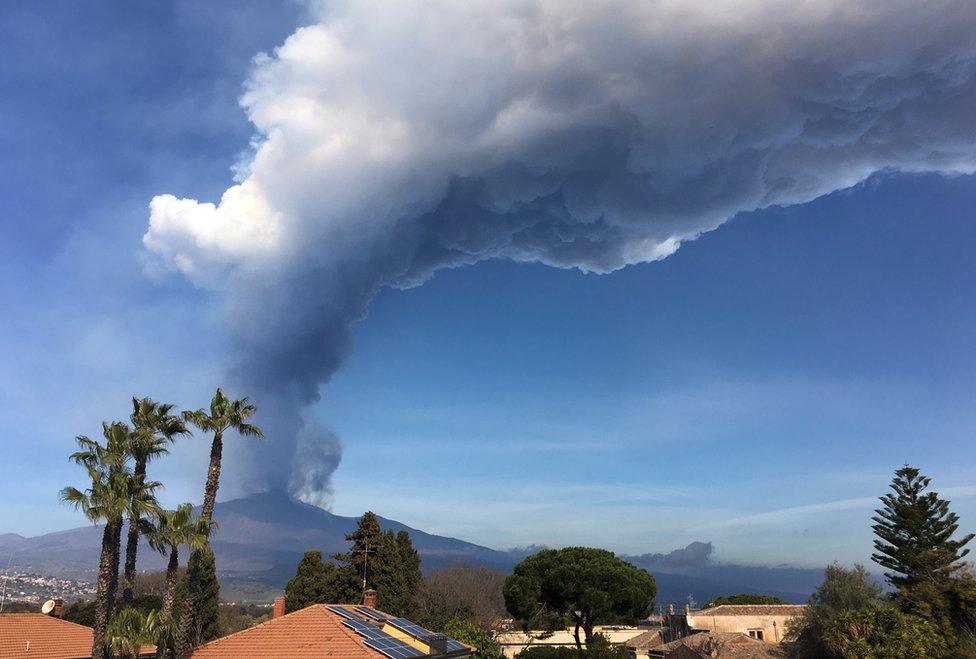
The eruptions may be spectacular, but they are a nuisance too.
Lava dust falls over my head and over my washing line. I have spent much of the past three weeks of curfew sweeping the floor.
My car windscreen is constantly covered by a dark patina of grime, but you must not use water to clear it. This glaze contains sharp glass particles that will scrape it beyond repair. No wonder some people have wrapped up their parked cars in bed-sheets to protect them.
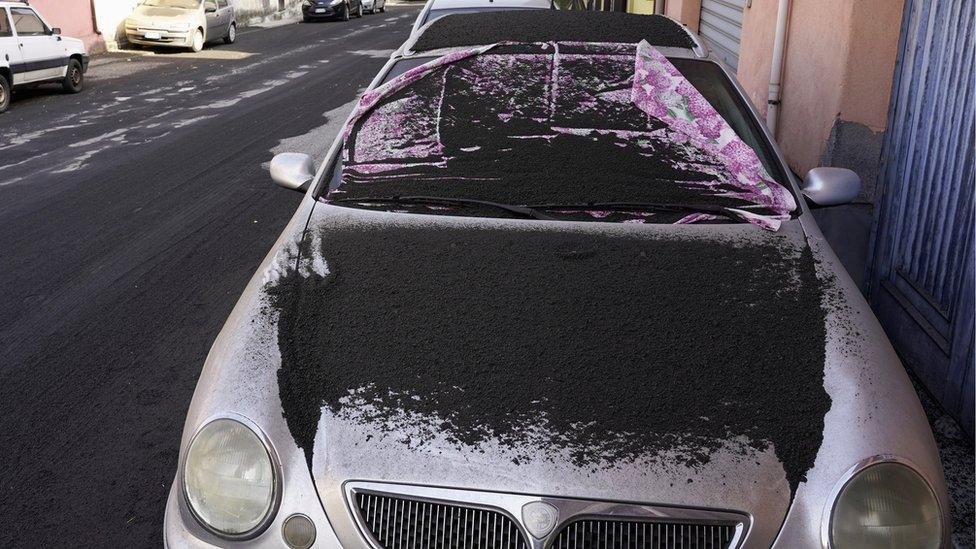
People have been using sheets to cover and protect their car windscreens
When it rains, the drizzle turns carpets of lava dust into something resembling concrete. It blocks gutters and drainage channels, prompting flooding and water seeping into houses.
Etna's explosions generate "infrasonic waves" that the human ear does not pick up because of their low sound frequency, but the glass in the windows does.
After so many eruptions, you can now tell what Etna is doing simply by listening to the trembling of the windows. It wakes you up with a jolt in the middle of the night. The sound of a column of ash and dust is different, more of a jingle-jangle.
Twelve tonnes of dust
The damage to the area has been immense and the Sicilian region has declared a crisis for 13 towns on Etna and another 30 surrounding the volcano.
Orange groves and other crops have been destroyed and on one occasion the motorway between Fiumefreddo and Giarre was shut to allow dust to be cleared. Motorbikes are banned and the speed limit has been cut to 20km/h.
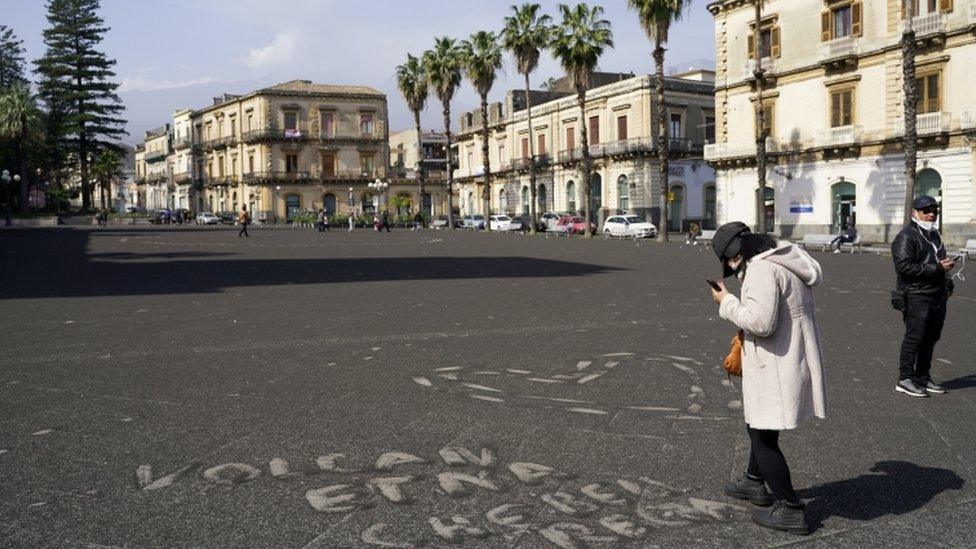
This message scrawled in the ash in the centre of Giarre reads: "Etna volcano, what a nice gift"
Schools in Giarre were shut for three days and the weekly market suspended. Locals have been instructed to collect the dust in transparent bags and not to mix it with ordinary rubbish.
"We have to deal with six kilos of volcanic dust in every square metre, with a total of 12 tonnes," Giarre Mayor Angelo D'Anna told the BBC.
"The latest black rain lasted just 30 minutes and generated as much rubbish as we usually have in a year. It'll cost up to €600,000 (£510,000) and we are worried because it is going to happen again and again. How can we pay for it?"
The regional government is to provide €1m and will ask the Rome government for more help, but there is no regional plan to manage the dust. It may be a natural phenomenon, but it is treated as waste and there is not yet anything planned to remove it.

Sacks of ash are stacked up beside the road in the town of Zafferana Etnea
Sweeping balconies of black dust has become a regular event for the thousands who live in the towns around Etna.
Every roof, terrace, porch, veranda and geranium-adorned balustrade has turned black. Even gardens are barely green any more.
How unusual are the eruptions?
Etna is no stranger to these episodes. Despite the extraordinary amount of volcanic material that has erupted, experts agree the volcano is merely repeating previous patterns of behaviour. But they also admit that the power released is greater than before.
"In the past we witnessed two or three strong events, and others that were weaker," says volcanologist Boris Behncke. "Now every paroxysm is strong. Nonetheless, at the moment Etna is deflating, there is no more magma coming and its system is stable."
Living in the shadow of Mount Etna
I have sensed a change too. I have always seen an eruption with a flame that goes on and off like a lighter. This time I have seen at least three tongues of flame with lava fountains on both sides of Etna, and a constant wall of flame.
As long as the activity remains on the summit there is no danger. More eruptions are likely, but not even the experts can predict when.
Related topics
- Published23 February 2021
